The Blood Donation Badge of Honor (German : Blutspendeehrennadel) is a German award presented by the German Red Cross and by the Blood donation service of the Bundeswehr for voluntary unpaid blood donations.
The Blood Donation Badge of Honor (German : Blutspendeehrennadel) is a German award presented by the German Red Cross and by the Blood donation service of the Bundeswehr for voluntary unpaid blood donations.

The badge depicts a golden cross with a red dot in the center, symbolizing a drop of blood on red background. The awards of 25 or more donations feature a laurel wreath around the cross. The awards of 50 or more donations also feature diamonds around the center. The number of donations is also shown at the bottom of the laurel wreath. If worn as a ribbon bar, a miniature version of the badge is attached to a red ribbon bar.[ citation needed ]
Blood donation service of the German armed forces:
For 3; 6; 10; 15; 25; 40; 50; 75; 100; 125; 150; 175; 200; 225; 250; 275 and 300 donations.
Donors with three or ten blood donations receive their certificate of honor directly on site. Donors with 25 donations will receive their badge of honor on site and will be sent their certificate. In the local associations, donors are honored from the 50th donation. From the 75th donation, the design of the badge of honor differs in the form of a medal with the inscription "Donate blood save lives", a cross in a stylized drop of blood and a garnet in a double wreath. In addition, donors who donate more than 75 blood receive an invitation to a major cross-district donor honor. [1]
German Red Cross
For 10; 25; 50; 75; 100; 125; 150; 175; 200; 250; 275 and 300 donations.
Bavarian Red Cross
For 3; 10; 25; 50; 75; 100; 125; 150; 175; 200; 225; 250; 275 and 300 donations.
The ribbon is an official German medal according to the Law regarding Titles, Medals and Decorations. It is usually awarded by the local Red Cross chapter, the local mayor, or for military service members the ribbon is awarded by the commanding officer.
Members of the German fire departments, the Federal Agency for Technical Relief and other rescue services may wear the ribbon bar for the badge on their uniform or service dress.
The Blood Transfusion Service of the Bundeswehr awards a lapel pin to those soldiers who make voluntary donations of blood. The ribbon is currently not permitted to be worn on uniforms of the Bundeswehr.
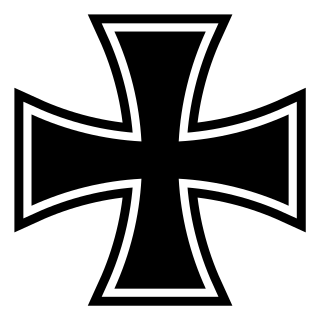
The Iron Cross was a military decoration in the Kingdom of Prussia, and later in the German Empire (1871–1918) and Nazi Germany (1933–1945). The design, a black cross pattée with a white or silver outline, was derived from the insignia of the medieval Teutonic Order and borne by its knights from the 13th century. As well as being a military medal, it has also been used as an emblem by the Prussian Army, the Imperial German Army, and the Reichswehr of the Weimar Republic, while the Balkenkreuz variant was used by the Wehrmacht. The Iron Cross is now the emblem of the Bundeswehr, the modern German armed forces.

An oak leaf cluster is a ribbon device to denote preceding decorations and awards consisting of a miniature bronze or silver twig of four oak leaves with three acorns on the stem. It is authorized by the United States Armed Forces for a specific set of decorations and awards of the Department of Defense, Department of the Army, and Department of the Air Force.

The Order of Orange-Nassau is a civil and military Dutch order of chivalry founded on 4 April 1892 by the queen regent, Emma of the Netherlands.
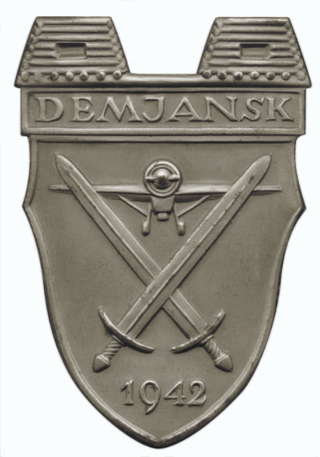
Demyansk Shield was a World War II German military decoration awarded to Wehrmacht personnel who fought in the Demyansk pocket on the Eastern Front in the early months of 1942. The pocket of German troops had been encircled and cut off by the Red Army around Demyansk (Demjansk), south of Leningrad, and was successfully defended with the aid of an airbridge. The shield was instituted on 25 April 1943 by Adolf Hitler and was not bestowed after 1 July 1944.

The Close Combat Clasp was a World War II German military award instituted on 25 November 1942 for participation in hand-to-hand fighting at close quarters. Intended primarily for infantry, other Wehrmacht, Waffen-SS, ground Luftwaffe units and paratroopers were also eligible.
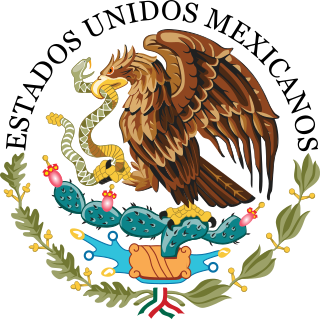
This is a list of military decorations awarded by the United Mexican States as part of the Mexican Honours System.
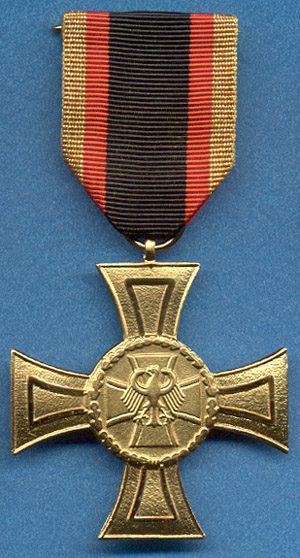
The Decorations of Honour of the Bundeswehr are a series of military decorations of the Bundeswehr, the armed forces of the Federal Republic of Germany. These honours and awards were introduced in 1980 on the occasion of the 25th anniversary of the Bundeswehr by then Minister of Defence Hans Apel and subsequently approved by President of the Federal Republic Karl Carstens.

The Austrian Imperial Order of Leopold was founded by Franz I of Austria on 8 January 1808. The order's statutes stipulated only three grades: Grand Cross, Commander and Knight. During the war, in common with the other Austrian and later Austro-Hungarian decorations, war decoration and/or swords were added to reward meritorious service and bravery in the face of the enemy.

The Panzer Badge was a World War II military decoration of Nazi Germany awarded to troops in armoured divisions. Before 1 June 1940 it was known as the Panzerkampfwagenabzeichen.

The German Armed Forces Deployment Medal is a decoration of the Bundeswehr, the armed forces of the Federal Republic of Germany. The decoration is awarded for military service in a designated military campaign. It is awarded to all German soldiers regardless of rank. It is also the only type of German campaign medal awarded, the only difference is the campaign bar worn on the medal and ribbon.

Bandit-warfare Badge (Bandenkampfabzeichen) was a World War II decoration of Nazi Germany awarded to members of the army, Luftwaffe, Order Police, and Waffen-SS for participating in Nazi security warfare (Bandenbekämpfung). The badge was instituted on 30 January 1944 by Adolf Hitler after authorization/recommendation by Heinrich Himmler.
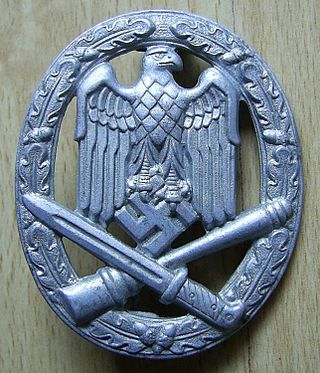
The General Assault Badge was a military decoration awarded during World War II to personnel of the German Army, Waffen-SS and Ordnungspolizei who supported an infantry attack but were not part of specific infantry units and therefore did not qualify for the Infantry Assault Badge. It was instituted by General Walther von Brauchitsch on 1 June 1940.
The term badge of honour may refer to a variety of awards and accolades, including:
Colombian military decorations date back as far as the founding of the country. An early decoration was the Cruz de Boyacá that was awarded to the generals who led their forces to victory in the Battle of Boyacá in 1819. This early decoration lives on today as an incarnation of the highest order presented by the Colombian state. There is one decoration higher, but it is only awarded for military conflicts in defence of Colombia. Other than military decorations, Colombia presents decorations on behalf of the National Government, decorations for the National Police, and decorations from the Congress of Colombia.
The Honour Roll Clasp was a decoration of Nazi Germany during World War II. There were different versions for the Army (Heer), Air Force (Luftwaffe) and Navy (Kriegsmarine).

The German rescue swimming badge is awarded by the Wasserwacht of the German Red Cross, the DLRG and the ASB for proficiency in rescue swimming skills. The German rescue swimming badge is awarded in bronze, silver, and in gold. The awards is available as a cloth patch, as a metal badge, or as a ribbon. The rescue swimming badges in silver and gold are permitted to be worn on uniforms of the Bundeswehr, the German Police and various rescue services as a ribbon. It is also an entry-requirement for some German Police agencies.

The Red Cross Medal was a German medal set up on 1 October 1898 by Wilhelm II. It had three classes and could be awarded to all those who carried out great service to the sick in peace or wartime, or for special achievement in the service of the German Red Cross. Though service to the sick during times of war had been recognized with prior awards of the Order of the Crown and General Honor Decorations with the Red Geneva Cross, Empress Augusta Victoria the royal patroness of the organization wanted an award to recognize work in peacetime as well.

The Awards and decorations of the German Armed Forces are decorations awarded by the German Bundeswehr, the German government, and other organizations to the German military and allied forces. Modern era German military awards have been presented since the establishment of the Federal Republic of Germany in 1949.

The Nazi Party Long Service Award, sometimes called the NSDAP Long Service Award, was a political award in the form of a badge of the Nazi Party.

The War Cross – Portuguese military decoration.